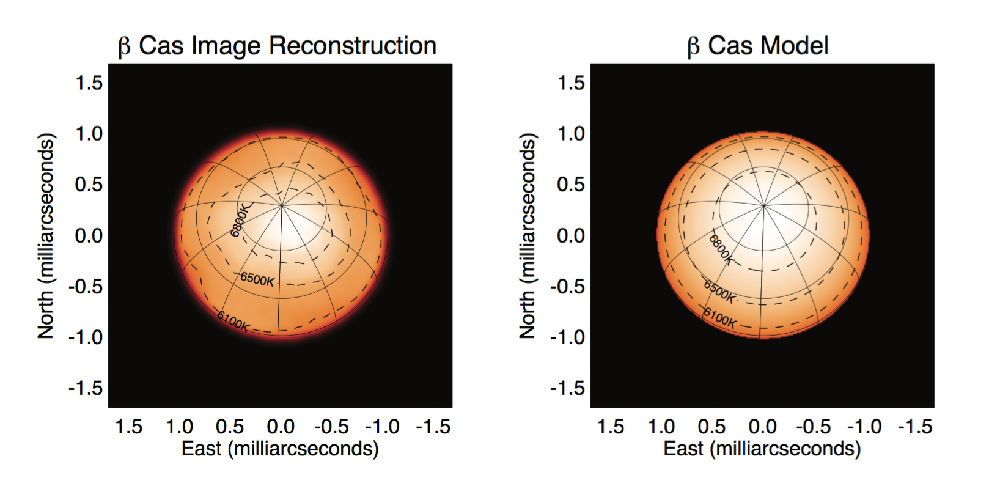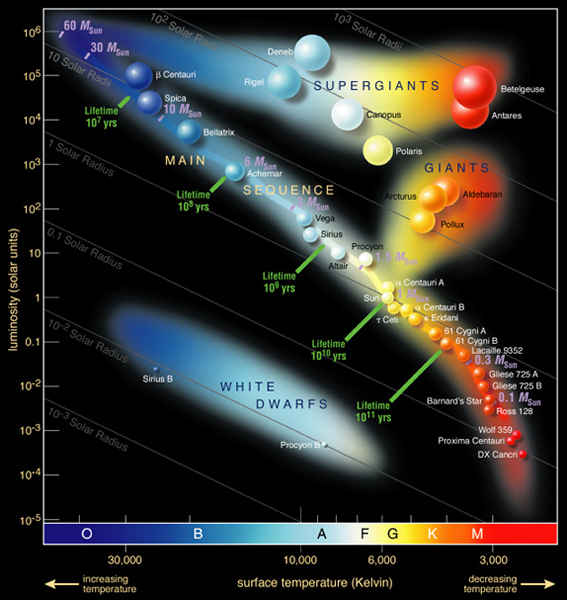博文
恒星绚丽的舞蹈如何误导了天文学家?
 精选
精选
|

封面图:对高速自转恒星β Cassiopelae (王良一)的观测(左)和模拟(右)比较,由于β Cassiopelae的高速自转,其表明的温度(颜色表示)分布已经不再均匀,其赤道附近的表面温度比两极低了接近700度。图片来源: X Che et al., ApJ (2011)
1、恒星的形成与演化
然而,恒星内部的核聚变不能无限持续,当内核的氢元素全部由于聚变燃烧殆尽时,恒星的核心开始熄灭,引力最终会取得胜利,新一轮的坍塌又将开始。主序寿命结束的恒星,它们将如何演化呢?这时,坍塌再一次使得恒星内核升温,它不足以点燃已经转变为氦的核心,却能让核心外围的氢燃烧起来。这时恒星开始膨胀,颜色也会逐渐变红,这时恒星离开主序带朝红端演化,由于膨胀,此时恒星的体积将显著大于主序星,人们将这一类恒星称之为巨星。图1展示的是恒星的颜色—亮度分布示意图,斜穿整个图片的便是主序带,而分布在主序带右上方(更红且更亮)的恒星是各种不同的巨星。

图1,恒星的颜色—亮度分布示意图,横轴表征的是恒星的颜色(表面温度),纵轴表征的是恒星的亮度。

图2,年龄分别为1亿年、2亿年和3亿年的三支单星族的颜色(表面温度)亮度分布,它们的主序拐点也随着年龄而逐渐在亮度上有所降低,图中每一个点都代表一颗恒星。

图3. 哈勃太空望远镜拍摄的正在从原始气体云中脱离开的年轻星团NGC 3603(图片来自NASA/ESA)
在大约几百万年之后,大质量恒星演化到了生命的最后阶段,它们将以超新星大爆炸的方式给予残余的气体云“致命一击”:超新星大爆炸能将星爆产生的物质最高加速到30000千米每秒,咆哮着的爆风携带着巨大的能量与残余的气体云发生猛烈碰撞,碰撞产生的强大激波在一瞬间将气体加速到几百甚至上千公里每秒,残留的气体云彻底被吹走,整个星团完全暴露在星际空间中,缺乏气体的星团彻底丧失了造星的能力,只有最初那一批及时形成的幸运儿继续留存在星团里,它们中的一部分将作为星团的成员星继续存在下去,还有一部分将通过动力学作用扩散到星系广袤的恒星场里成为场星。图4展示的星团是大麦哲伦云中的NGC1805,其年龄已经达到几千万年,它最初包含的大质量恒星已经演变成为了超新星将气体彻底吹走了,整个星团已经没有任何可探测的气体残留。

图4. 哈勃太空望远镜拍摄的年轻星团NGC 1805(图片作者 Fabian RRRR)

图5. 星团NGC188和M67的恒星的颜色亮度分布,注意两个星团由于年龄不同,其主序拐点的位置也不一样,但它们都符合单星族的理论模型(读者可以与图2进行定性的比较)。
然而大约10年以前,问题出现了,天文学家们利用哈勃太空望远镜观测南半球的两个卫星星系——大小麦哲伦云星系时发现,它们所包含的绝大部分年轻星团,不存在清楚的主序拐点。2009年,来自意大利帕多瓦天文台的一支研究团队详细分析了大麦哲伦云中16个年龄处于10亿到30亿年的星团的恒星颜色亮度分布图,发现其中至少有12个星团的恒星,其颜色亮度分布图上的主序转折区域远宽于单星族的主序拐点。图6展示了其中一个大麦哲伦云星团NGC1783的恒星的颜色亮度分布,读者可以自行与图2或者图5进行比较,与狭窄的主序带形成鲜明对比的是,这一星团的主序拐点大大地展宽(在图中我们用两根蓝色的实线标注的区域)。由于恒星的主序年龄与其质量有着非常单调的对应关系,单星族在任何给定的演化阶段都不可能出现展宽的主序拐点。对这一观测现象的最直接解释是这些星团不是单星族,而是在至少3亿年以上的时间里,它们都在陆陆续续地形成恒星,因此当我们观测这些星团时,才会出现质量不同的恒星同时离开主序带的演化场景,从而呈现出一片展宽的主序转折区域。
图6. 年轻而致密的星团NGC1783,似乎包含着超过3亿年恒星形成历史的各种年龄的恒星,这一时间远远超过了星团最初的气体排除时标。

图7. 包含不同自转速度的单星族恒星的颜色亮度分布图。
然而这一模型遭到了另一团队的反对,他们指出,自转不仅会导致恒星的表观亮度发生改变,也会影响恒星的演化轨迹,高速自转的恒星能够扩大内部的对流,从而将外围更多的氢输送到恒星的核心,这就相当于给恒星核心添加了更多的燃料。这一自转导致的混合效应能够延长恒星的主序寿命,从统计上看高速自转的恒星反而会分布在更蓝的主序转折区域,这与引力昏暗效应造成的主序展宽方向完全相反,如果同时考虑引力昏暗效应和自转混合效应,那么单星族的主序拐点大小就刚好不增不减,因此自转并不足以解释星团里观测到的宽敞主序转折区域。
5、新的突破——巨星能告诉我们它们是何时形成的

图8. 中间是星团NGC1651恒星的颜色亮度分布图,左边是观测对应的误差水平,右图是对应的恒星数密度的颜色亮度分布。该星团的转折区域需要用年龄相差4.5亿年的两条理论曲线才能“围起来”,然而,它的巨星却只能与年轻的一条曲线(蓝色虚线)拟合。
我们的工作随之推广到了小麦哲伦云的星团里,对小麦哲伦云,人们发现其中两个星团NGC411和NGC419,其主序转折区域异常的大,如果用恒星持续形成(而不是单星族)来解释这一扩大的主序转折区域,则它们最初的恒星形成过程可能持续了将近七亿年。我们再一次发现这两个星团的巨星带与这一模型不符,由于我们关注的巨星带是恒星演化的一个非常快速的阶段,因此在NGC411的颜色亮度分布图上,有用的巨星数目只有18颗,而其中14颗巨星严格地与单星族分布一致,其余三颗也十分靠近单星族的理论轨迹,处于测光误差范围内,只有一颗恒星远远地亮于单星族的位置,然而,通过统计分析,我们认为这很可能是一个包含两颗质量接近的恒星的双星系统。而与NGC411相比,NGC419的巨星带呈现出更加有趣的特征,NGC419包含的恒星数目远高于NGC411,因此它拥有上百颗巨星可供我们分析,拥有了足够的样本之后,我们惊奇地发现,在与主序转折区域靠近的位置,巨星的亮度分布还是高度均匀的,其于扩展的主序转折区域连续地连接在一起,然而,随着巨星逐渐膨胀变红,其亮度分布开始逐渐集中,最后合并成为了一条与单星族相符合的巨星轨迹。这一“收敛”的巨星带与恒星自转模型高度相符合,巨星的颜色本身也代表了它们的体积,巨星变红意味着它们的体积越来越大,其自转角速度也越来越低,而由于它们本身是同时形成的单星族,随着自转效应的减弱,它们最终又回归到了单星族预言的轨迹上(图9)。

图9. 小麦哲伦云星团NGC419的成员星的颜色亮度分布图,如果不考虑自转效应,则它们的主序转折区域需要两条不同年龄的单星族轨迹才能完全包围起来(红色实线和蓝色实现),然而,离开主序转折区域的巨星呈现出逐渐变窄的趋势,以黑色虚线为界,其右侧的巨星要比左侧更加狭窄。此处数据点的颜色代表的是如果不考虑自转效应,人们将得到的恒星的不同年龄(单位:10亿年)。
由于星团致密的恒星环境,测量星团中单颗恒星的光谱来计算恒星的自转速度难度很大,因此目前对恒星自转的测量都是针对稀疏的星系场中的恒星,而尽管争议重重,星团目前仍然被认为是好的单星族,对星团成员星测量自转速度就能在其它物理参数不变的情形下来估计自转对恒星演化的影响。因此只有对致密星团中恒星的自转进行测量,才能够真正地增进我们对恒星结构与演化的理解,这也是基于目前已有的天文设备以及下一代望远镜,有关恒星物理的热点研究方向之一。
参考文献:
[1] Baumgardt H. & Kroupa P. 2007, MNRAS, 380, 1589
[2] Bastian N. et al. 2013, MNRAS, 436, 2852
[3] Milone A. P. 2009, A&A, 497, 755
[4] Mucciarelli A. et al. 2008, AJ, 136, 375
[5] Mucciarelli A. et al. 2011, MNRAS, 413, 837
[6] Bastian N. & de Mink S. 2009, MNRAS, 398, 11
[7] Che X. et al. 2011, ApJ, 732, 68
[8] Li C. et al. 2014, Nature, 516, 367
[9] Li C. et al. 2016, MNRAS, 461, 3212
[10] Wu X. et al. 2016, ApJL, 826, L14
https://blog.sciencenet.cn/blog-80023-1022423.html
上一篇:纪念我的爷爷
下一篇:看见
7 季顺平 史晓雷 邹远川 俞云伟 张潇 徐耀 nuobeier1997
该博文允许注册用户评论 请点击登录 评论 (7 个评论)

-
|
 璧�
+1
[36]鍛ㄥ缓鏂�
璧�
+1
[36]鍛ㄥ缓鏂�
- 濡傛灉鍚勪綅鏈変竴浣嶈鏂硅垷瀛愰《涓婏紝涓嶅彂鐤墠鎬€傚懙鍛�

-
|
 璧�
+1
[35]寮犳睙鏁�
璧�
+1
[35]寮犳睙鏁�
- 鎵繙涓€鐐癸紝12骞村墠锛岃疆瀛愭暀鐚栫崡銆傗€滆翰杩涘皬妤兼垚涓€缁燂紝绠′粬鍐涓庢槬绉嬧€濓紝浣犵寲鐛楀共鎴戠敋浜�?! 闈炲父涓嶅垢鐨勬槸锛屾垜鐨勪竴浣嶆湅鍙嬩唬琛ㄦ垜浠叏浣撳悓瀛﹀湪缃戠粶涓婂彂甯栧瓙璇磋疆瀛愭暀涓嶈繃寮鸿韩鍋ヤ綋锛岃繕璇存垜浠竴鑷存敮鎸佽繖绉嶄綋鑲叉椿鍔紝鎶婃垜鍜屽嚑浣嶅悓瀛︽伡缈讳簡銆備簬鏄垜鍦ㄦ柟鑸熷瓙鍙戝姩鐨勪竴涓鍚嶆椿鍔ㄤ腑涔熷崰浜嗕竴涓綅缃紝鍒嗛噺鍦�1/1000閲忕骇銆傝繖涓椿鍔ㄦ湁浜涘皬鏁呬簨锛岄兘浠€涔堟椂浠g殑浜嬪憿? 杩界储鍘嗗彶涔熸湭蹇呮湁瓒o紝鐪佸幓涓嶈皥銆備笉杩囷紝濡傛灉浣犲幓缇庡浗鐗瑰埆鏄航绾︼紝杞瓙鏁欎竴瀹氫笉浼氭斁杩囦綘銆傚緢鏄鍘岋紒锛佺壒鍒槸锛岃疆瀛愭暀鏈変釜鐢佃鍙帮紝鎼炰簡涓€鍙板憰鍚愬害闈炲父楂樼殑姝岃垶鑺傜洰锛岃灏忓績璧伴伩銆�
=============================================================
鎴戝浣犵殑鍗拌薄涓€钀藉崈涓�
鍑犲崄宀佺殑浜洪兘鎯充笉鏄庣櫧鍏朵腑閬撶悊锛熷ソ瀛︾墿鐞嗙殑
杞瓙鐨勬晫浜猴紝鎭愭€曟瘮杞瓙鎭跺績涓囧€嶅惂

-
|
 璧�
+1
[34][娓稿]妗戝叞鐨勪富娌诲尰鐢熷苟涓嶆帹鑽�
璧�
+1
[34][娓稿]妗戝叞鐨勪富娌诲尰鐢熷苟涓嶆帹鑽�
- 2010-10-09 浠婂ぉ绾︿簡鐟炴牸绾虫.鍖荤敓澶锛堟鍏扮殑涓绘不鍖荤敓锛夋潵宸濇櫘楂樺皵澶悆鍦烘墦鐞冿紝姝eソ閬囧埌鍞愮撼锛嶅窛鏅湰浜哄湪鐞冨満涓婃暀浠栫殑鍎垮瓙鎵撶悆銆傝繖涓効瀛愭槸宸濇櫘鍜屾渶鏂颁竴浠诲か浜虹殑缁撴櫠鍝侊紝鎹鏄粬鐨勬渶鐖便€傜敱浜庡窛鏅嚑涔庢瘡鏄熸湡閮芥潵鎵撶悆锛屼粬鍜屼粬鐨勫浜烘垜浠粡甯歌鍒帮紝鏃╁凡涔犱互涓哄父锛屼絾鏄€煎緱涓€鎻愮殑鏄紝杩欎釜瀛╁瓙寰堟湁鏁欏吇锛岀粷娌℃湁瀵屽瀛愬紵鐨勯偅绉嶇洰涓棤浜虹殑鍤e紶姘斿娍锛屽钩鏃跺湪椁愬巺瑙佸埌浠栨椂锛屼粬閮借瑙勭煩鐭╁湴鍧愬湪搴т綅涓婏紝涓嶄細婊″湴涔辫窇锛屼篃浠庝笉澶у0鍙枈锛岃鍒版垜浠兘涓诲姩璇粹€滃搱缃椻€濓紝寰堟湁绀艰矊銆傝繖鍙兘鏄鏁欑殑缂樻晠锛屽洜涓哄窛鏅湰浜鸿鍒版湰浼氫細鍛樹篃鎬绘槸涓诲姩浜插垏鎵撴嫑鍛硷紝浠栨槸涓€涓垚鍔熺殑鍟嗕汉锛岃繖閲岀殑姣忎竴涓細鍛樺湪浠栫溂閲岄兘鏄鎴凤紝浠栧湪瀹㈡埛闈㈠墠鎬绘槸鏈兘鍦板崄鍒嗚唉閫娿€�
鐟炴牸绾虫.鍖荤敓鏄鍏�12骞村墠鍦ㄧ編鍥藉悍澶嶆湡闂寸殑涓绘不鍖荤敓锛岃繖娆¤闈紝鎴戜滑璋堣捣杩囧幓鎴戜滑閮芥帴瑙﹁繃濡備粖鍗磋閫崟浜嗙殑鑲栦紶鍥藉尰鐢熴€傛鍏板湪缇庡浗搴峰鏈熼棿锛岃倴浼犲浗鍖荤敓鏇剧粡鏉ユ壘杩囨鍏帮紝鍔ㄥ憳濂规帴鍙椾粬鐨勬墜鏈不鐤椼€傛鍏板洜涓哄綋骞寸殑鎰忓锛岃兏閮ㄤ互涓嬪け鍘荤煡瑙夛紝涓嶈兘鎺у埗澶у皬渚匡紝鏍规嵁鑲栦紶鍥藉尰鐢熺殑鐨勫缓璁紝鎶婃鍏扮殑鑵块儴绁炵粡鍒囨柇锛屾帴鍒板ス鐨勮唨鑳变笂鍘伙紝鐢ㄥ埡婵€鑵块儴鐨勫姙娉曟潵鎺у埗灏忎究銆傛垜浣滀负妗戝叞褰撳勾鍦ㄧ編鍥界殑鐩戞姢浜猴紝涓庢鍏拌璁鸿繖涓€娌荤枟鏂规鍚庯紝鍐冲畾涓嶄簣閲囩撼锛屽師鍥犳槸杩欎釜鍔炴硶鑳藉惁鎴愬姛骞舵棤淇濊瘉锛岃€屽垏鏂吙閮ㄧ缁忓嵈鑲畾閫犳垚姘镐箙鎬ф崯浼わ紝灏嗘潵涓囦竴鏈夋柊鐨勬不鐤楀姙娉曚娇寰楁鍏版仮澶嶈唨鑳卞姛鑳斤紝灏变細鍚庢倲鐮村潖浜嗚吙閮ㄧ缁忋€�
鏍规嵁鎴戜滑鍦ㄥ浗澶栨墍浜嗚В鐨勬儏鍐碉紝杩樻病鏈夎倴浼犲浗鐨勬墜鏈垚鍔熺殑瀹炰緥銆傚鏋滅湡濡備粬鎵€璁茬殑杩欎箞绁炲锛屼粬鍦ㄧ編鍥藉氨鍙互鍙戝ぇ璐€€傜憺鏍肩撼妫尰鐢熶笉鎺ㄨ崘鑲栦紶鍥斤紝鍏跺師鍥犱笉瑙h嚜鏄庛€�
鐢变簬鏂硅垷瀛愭墦鍋囷紝鏂簡鑲栦紶鍥界殑璐㈣矾锛岀粓浜庝护浠栨毚闇蹭簡鑷繁鐨勭湡闈㈢洰锛屽彲璋撶姜鏈夊簲寰椼€�
http://www.sinovision.net/blog/index.php?act=details&id=41028&bcode=zhuoma

-
|
 璧�
+1
[33][娓稿]璺汉
璧�
+1
[33][娓稿]璺汉
- 瀵瑰崥涓昏繖绉嶅鐪熺殑涓炬帾锛岃禐涓€涓紒

-
|
 璧�
+1
[32][娓稿]000
璧�
+1
[32][娓稿]000
鍦ㄥ浗鍐呭仛涓腑鍥戒汉浼间箮寰�"鏉簡涓叿",
杩為€涜涔熷緱褰撲簡"涓撳"鎵嶈,
鑷冲皯寰楅€変慨杩�"閫涜涓撲笟",
鍚﹀垯,
"鐪嬩粈涔堢湅?
"闂粈涔堥棶?
"鎯充粈涔堟兂?
...鎴�...鎴�...鎴�."涓珛"...
"涓粈涔堜腑?
.......
"鍒樻暀鎺�,
"浜嗛偅涓幓"鐨勫緢鎼炵瑧.
鍗氫富鍥炲锛氣€滀簡閭d釜鍘烩€�? 鍙互鍙互銆備絾鏄紝澶€ュお澶氱殑璇濓紝浜哄氨鏅曡彍浜嗭紒

-
|
 璧�
+1
[31][娓稿]浣犵瓑灏辩渷浜嗗惂锛岃鑲栧畨蹇�
璧�
+1
[31][娓稿]浣犵瓑灏辩渷浜嗗惂锛岃鑲栧畨蹇�
- 杩欓噷鏈変綅璇村浗鍐呭彂鐨勬枃绔犻兘鏈変竵鐐归棶棰橈紝璇翠互鏂�......銆傝杩欒瘽鐨勪汉鏄病鎬庝箞浜嗚В鏂圭殑鎵撳亣鏂圭暐锛岃繖鏍疯涔熸妸鍥藉唴鐨勫叏榛戜簡锛岄毦閬撳厷鍥藉氨娌′竵鐐逛寒鍏夛紒
鍗氫富鍥炲锛氶兘鎵撳浗鍐呮枃绔犱簡? 浜烘墠鍟�!

-
|
 璧�
+1
[30][娓稿]鍗氫富浣曟椂鍏竷
璧�
+1
[30][娓稿]鍗氫富浣曟椂鍏竷
- 绛惧悕鑰呬箣涓€鐨勫洖澶嶏紵
鍗氫富鍥炲锛氬攭锛屼粬鐨勭‘绛句簡鍚嶏紝浣嗘槸骞朵笉浜嗚В鏈€杩戠殑鏂硅倴涔嬩簤锛屼笉鎰挎剰鏇存繁鍦拌箽杩欒稛娴戞按銆�

-
|
 璧�
+1
[29][娓稿]qsy
璧�
+1
[29][娓稿]qsy
- 锛堟帴涓婏級
鐜板湪鎸鸿倴鍙嶆柟鑰呬腑锛屾湁涓€浜涙槸鍘熷厛璺熸柟闂圭炕浜嗙殑浜恒€傜幇鍦ㄦ垜浠氨鏉ュ垎鏋愪竴涓嬩粬浠殑琛屼负鎴愭湰鍜屾晥鐩婏細鐢变簬杩欎簺浜哄凡缁忚窡鏂圭炕鑴革紝鐜板湪鏂瑰崰鎹亾寰峰埗楂樼偣锛屾樉鐒舵槸瀵逛粬浠潪甯镐笉鍒╋紝鍥犱负鍏紬浼氳涓猴紝鏂规槸姝g‘鐨勶紝浠栫殑鏁屼汉鏄剧劧灏辨槸閿欑殑銆傚洜姝わ紝鍋囧鍙兘鍙嶆柟鎴愬姛锛屽浠栦滑鏉ヨ鏁堢泭鏄法澶х殑銆傜敱浜庤繖浜涗汉宸茬粡璺熸柟鏈夐暱鏈熸仼鎭╂€ㄦ€紝鐭ユ牴鐭ュ簳锛屽弽鏂瑰浠栦滑鏉ヨ骞舵病鏈夊鍔犲お澶х殑鎴愭湰锛屾尯鑲栧垯鍙兘闇€瑕侀噸鏂颁簡瑙d簨瀹炵湡鐩革紝鍥犳鏈変竴瀹氱殑鏃堕棿绮惧姏鎴愭湰銆備絾涓庢晥鐩婃瘮璧锋潵锛屼粬浠樉鐒惰涓哄€煎緱涓€鍋氥€備竴鏂归潰鍙互涓鸿嚜宸辨壃鐪夊悙姘旓紝鍙︿竴鏂归潰涔熷彲浠ヨ涓烘槸涓轰腑鍥藉鐣岃蛋涓婃杞ㄤ綔鍑轰簡璐$尞銆�
閫氳繃鑲栨柟浜嬩欢鍥磋鑰呯殑琛屼负鍒嗘瀽锛屾垜浠簲璇ュ氨浼氬緢娓呮涓轰粈涔堝獟浣撳拰鍏紬閭d箞鍠滄绔欏湪閬撳痉鍒堕珮鐐圭棝鎵撹惤姘寸嫍銆佸鍊掍紬浜烘帹浜嗐€傛垜浠篃搴旇寰堟竻妤氾紝涓轰粈涔堢瀛︾綉閭d箞澶氭棤鑴戣€呬汉浜戜害浜戯紝楂樺枈鈥滃琛屼笉涔夊繀鑷瘷鈥濅簡銆傛垜浠篃搴旇娓呴櫎涓轰粈涔堢瀛︾綉閭d箞澶氬崥涓诲仛浜嗘矇榛樼殑澶у鏁颁簡銆�
绉戝缃戠殑澶у疂鍚屽绔欎簡鍑烘潵锛屼綘浠紙褰撶劧鍖呮嫭鎴戯紝鎵€浠ヨ璇存垜浠級锛岄兘褰撲簡缂╁ご涔岄緹锛屾妸澶у疂褰撴灙浣裤€�
璋佸彨澶у疂鏄勾杞讳汉鍛紝涓嶆垚鐔熷晩锛屾垚鐔熺殑浜轰釜涓兘鎴愪簡浜虹簿銆�
鍋氫汉绮炬槸涓汉鐨勮嚜鐢憋紝鎴戜滑鏃犳潈骞叉秹銆備絾鏄紝瀵归偅浜涙病鏈夎剳瀛愮殑銆佸枩娆㈢珯鍦ㄩ亾寰峰埗楂樼偣涔夋瑷€杈炲湴鎸囪矗浠栦汉鐨勪汉锛屾垜鍗磋璇翠綘浠笉浠呮剼锠紝鑰屼笖鍙伓锛�
锛堝畬锛�
鍗氫富鍥炲锛氬獟浣撻兘绔欏湪鏂硅繖涓€杈瑰悧? 瀵规柟鍙嶆劅鐨勪汉娴蜂簡鍘讳簡!

-
|
 璧�
+1
[28][娓稿]qsy
璧�
+1
[28][娓稿]qsy
- 锛堟帴涓婏級
鍏舵锛屾垜浠啀鏉ュ垎鏋愪竴涓嬫尯鑲栧弽鏂圭殑琛屼负鎴愭湰鍜屾晥鐩婏細
鎴戜滑鍙互鍙戠幇锛屾尯鑲栧弽鏂圭殑琛屼负鎴愭湰宸ㄥぇ鍜屾晥鐩婄敋寰垨闅句互鐭湡鏄剧幇銆傝倴宸茬粡鍦ㄥ獟浣撳拰璀︽柟鈥滃鍒も€濈殑鎯呭喌涓嬶紝鎸鸿倴闇€瑕佽川鐤戝獟浣撳拰璀︽柟锛屽叾鎴愭湰鐢氳嚦鍗遍櫓鏄法澶х殑銆備竴鏂归潰锛屾寲鎺樼湡鐩搁渶瑕佹姇鍏ュぇ閲忕殑鏃堕棿绮惧姏锛屽幓浜嗚В鍙屾柟杩�10骞存潵鐨勬仼鎭╂€ㄦ€紝鑷冲皯闃呰浜︽槑鐨勪功鏄繀瑕佺殑锛屽ソ鍑犵櫨椤电殑涔﹁璧锋潵涔熸槸闇€瑕佽垂鏃堕棿鐨勩€傚彟涓€鏂归潰锛屾尯鑲栨湰韬叿鏈夊緢澶х殑鍗遍櫓鎬с€傛柟闆嗗洟鍒板鎸ヨ垶鈥滄墦鍋団€濆ぇ妫掞紝宸茬粡璧㈠緱鍥藉唴涓绘祦濯掍綋鈥滄墦鍋囪嫳闆勨€濈殑鍚规崸锛屽鏂圭殑璐ㄧ枒闅忔椂鍙兘琚柟鐨勫ぇ妫掍竴妫嶅瓙鎵撴銆傚儚澶у疂杩欐牱鐨勪竴涓湪璇诲鐢燂紝鍙戣〃涓€浜涚嫭绔嬫€濊€冪殑鏂囧瓧锛屽眳鐒朵篃琚繘鍏モ€滄墦鍋囪嫳闆勨€濈殑娉曠溂锛屾仺涓嶅緱浜哄鍗冲埢閫€瀛︺€傚浗鍐呭鑰呭彂琛ㄦ枃绔狅紝鍝釜娌℃湁涓佺偣鐟曠柕锛熻皝瑕佹槸鑳嗘暍璐ㄧ枒鏂癸紝鍒欏繀瀹氭垚涓烘柟鈥滄墦鍋団€濈殑瀵硅薄銆傛浌骞跨鑰佸笀浠呬粎鍙戣〃浜嗕竴鐐逛釜浜虹湅娉曪紝绔嬪嵆灏遍伃鍒版姤澶嶏紝灏辨槸鏄庤瘉銆傛尯鑲栧弽鏂癸紝鍦ㄨ倴宸茬粡琚獟浣撳拰璀︽柟瀹e竷鏈夌姜鐨勬儏鍐典笅锛岀珛瓒崇偣宸茬粡鏄浜庨亾寰峰姡鍔裤€傛柟鍦ㄥ浗鍐呭獟浣撳拰璀︽柟鐨勫ぇ鍔涙敮鎸佷笅锛屽彧闇€瑕佸甯冭川鐤戣€呮槸琚粬鎵撹繃鍋囩殑浜恒€佹垨鑰呴€犺繃鍋囩殑浜恒€佹悶浼瀛︾殑浜恒€佲€滆疆瀛愬姛鈥濓紝璐ㄧ枒鑰呭氨鍑犱箮宸茬粡娌℃湁缈昏韩涔嬫棩浜嗐€備簨瀹炰笂锛屾柟鍙婂叾鏀寔鑰呭氨鏄緷闈犺繖绉嶆墜娈靛皝鏉€涓€鍒囪川鐤戝拰鍙嶅鏂圭殑浜恒€傛墍浠ワ紝鎸鸿倴鍙嶆柟鐨勯闄╂瀬澶с€傛尯鑲栧弽鏂逛笉浠呮垚鏈法澶э紝鑰屼笖鍑犱箮娌℃湁浠讳綍涓汉鏁堢泭锛屽亣濡傛湁鏁堢泭鐨勮瘽锛屼篃鏄涓浗绉戝鐣屾暣浣撴湁鐩婏紝涓烘竻闄や腑鍥界瀛︾晫鐨勬瘨鐦や綔鍑鸿础鐚€傝瘯鎯筹紝涓€涓汉锛屽亣濡傚畬鍏ㄤ笌鑲栨柟娌℃湁浠讳綍鐡滆憶锛岃嚜宸辨病鏈夐€犺繃鍋囷紝鎼炩€滀吉绉戝鈥濇垨鍙備笌鏌愭煇鍔燂紝鐢氳嚦涓嶇浉淇′腑鍖伙紝鏀寔杞熀鍥狅紝浠栧湪涓嶄簡瑙g湡鐩哥殑鎯呭喌涓嬶紝浼氬湪濯掍綋鍜岃鏂圭殑缁撹闈㈠墠鍋氬拰閫夋嫨锛熶粬鑻ヤ簡瑙g湡鐩革紝浠栭兘澶氬ぇ鐨勫媷姘旂珯鍑烘潵鎻ず鐪熺浉锛岃€屼笉鎬曟児涓€韬噴锛屽嵎鍏ュ嚑涔庡繀杈撴棤鐤戠殑璁烘垬锛�
锛堝緟缁級

-
|
 璧�
+1
[27][娓稿]qsy
璧�
+1
[27][娓稿]qsy
- 鑲栨柟浜嬩欢鍥磋鑰呯殑琛屼负鍒嗘瀽
绉戝缃戣祫娣辨綔姘村憳
鍥寸粫鑲栨柟浜嬩欢锛岀瀛︾綉浜夎涓嶄紤宸茬粡涓€涓鏈堜簡銆傛垜浠埌搴曡鐩镐俊璋侊紵
鏂逛互鎵撳亣鍑哄悕锛屽浗鍐呭獟浣撳嚑涔庝竴闈㈠埌搴曟敮鎸佷粬銆傝倴琚墦鍋囷紝鍥藉唴濯掍綋鍑犱箮娌℃湁浜烘闈㈡姤閬撲粬銆傝鏂规姄鑾蜂簡鑲栵紝鑲栧凡缁忎緵璁ゃ€傚湪杩欑鎯呭喌涔嬩笅锛屼綘浼氱浉淇¤皝锛�
瀵规锛屾垜浠潵鍋氫竴涓倴鏂逛簨浠跺洿瑙傝€呯殑琛屼负鍒嗘瀽锛屽垎鏋愪竴涓嬪洿瑙傝€呯殑琛屼负鎴愭湰鍜屾晥鐩婏紝灏卞彲浠ョ瀛﹀湴瑙i噴鍥磋鑰呯殑琛屼负銆�
棣栧厛锛屾垜浠潵鍒嗘瀽涓€涓嬫尯鏂瑰弽鑲栫殑琛屼负鎴愭湰鍜屾晥鐩婏細
鎴戜滑鍙互鍙戠幇锛屾尯鏂瑰弽鑲栫殑琛屼负鍑犱箮娌℃湁浠讳綍琛屼负鎴愭湰銆備粬浠彧闇€瑕佽交鏉惧湴鎺ュ彈鍥藉唴涓绘祦濯掍綋鐨勬柊闂绘姤閬撳拰璀︽柟鐨勭粨璁哄氨琛屼簡锛屼笉鐢ㄨ嚜宸辫姳鏃堕棿鍜岀簿鍔涘幓鎸栨帢鐪熺浉銆傝€岄€夋嫨鎸烘柟鍙嶈倴鐨勮涓烘晥鐩婂嵈鏄槑鏄剧殑锛氱珯鍦ㄩ亾寰峰埗楂樼偣锛岃鑷繁绔嬩簬涓嶈触涔嬪湴銆備富娴佸獟浣撲竴闈㈠€掑湴鎸烘柟鍙嶈倴锛岃鏂归珮璋冪牬妗堬紝鏋佺閲嶈锛岀珯鍦ㄢ€滄斂娌绘纭€濅竴鏂规樉鐒舵槸瀹夊叏鐨勩€傚彟涓€鏂归潰锛屼箟姝h瘝涓ュ湴鎸囪矗閫犲亣鑰咃紝涔熸槸缁欒嚜宸辫韩涓婃壒涓€浠跺琛o紝璐翠笂鍧氬喅鏀寔鎵撳亣鐨勬爣绛撅紝鑳藉鎺╃洊鑷繁鏇剧粡閫犲亣鐨勫姡琛岋紙鍋囧鏇剧粡閫犲亣鐨勮瘽锛夈€�
锛堝緟缁級

-
|
 璧�
+1
[26][娓稿]缈昏瘧
璧�
+1
[26][娓稿]缈昏瘧
- 杩欏皝鎵€璋撳叕寮€淇$殑鑻辨枃闈炲父鎷欏姡锛屾槸鍦伴亾鐨勪腑鍥藉紡鑻辫锛屼笉鐭ユ槸鍝釜绗ㄨ泲鑽夋嫙鐨�
鍗氫富鍥炲锛氳嫳鏂囪繕鏄祦鐣呯殑!

-
|
 璧�
+1
[25]seeulater
璧�
+1
[25]seeulater
- community鎸囦竴鎵逛汉锛屼竴缇や汉銆傜ぞ鍖哄眳濮斾細鐨勨€滅ぞ鍖衡€濆氨鐢ㄨ繖涓瘝銆�
鍦ㄨ繖閲屽簲璇ユ寚1. g : a body of persons of common and especially
professional interests scattered through a larger society <the academic community> 锛坢erriam-webster)
鍗氫富鍥炲锛歝ommunity == a large society.

-
|
 璧�
+1
[24][娓稿]coolboy
璧�
+1
[24][娓稿]coolboy
- 鑲栨暀鎺堝洖鍥藉墠鍦ㄧ航绾﹀ぇ瀛﹀尰瀛﹂櫌宸ヤ綔澶氬勾锛屼笖鏄壇鏁欐巿銆傞偅閲岀殑缇庡浗浜哄簲璇ュ浠栦簡瑙f渶澶氥€傝繖31浣嶅浗闄呭鏈悓浠佷腑鏈夌航绾﹀ぇ瀛﹀尰瀛﹂櫌鐨勬暀鎺堝悧锛�
鍗氫富鍥炲锛歂O!

-
|
 璧�
+1
[23]鍞愬噷宄�
璧�
+1
[23]鍞愬噷宄�
- 鈥滃彟澶栵紝4妤肩殑鐣欒█鏄剧ず锛屼箣鍓嶅氨鏈変汉鎬€鐤戣繖灏佷俊鐨勭湡瀹炴€у苟鎵撶數璇濇牳瀹炶繃銆�
鎴戠幇鍦ㄧ浉淇¤繖31浣嶄笓瀹跺簲璇ラ兘鐪嬭繃閭e皝淇″苟涓旇鍚屼俊浠剁殑鍐呭銆傗€� 鍒樿€佸笀锛屼粠閫昏緫涓ヨ皑鐨勮搴︿笂鏉ヨ锛屽簲璇ュ31鏈鍚嶈€呭叏閮ㄨ仈绯绘墠鍙互鐩镐俊銆�
鍗氫富鍥炲锛�31鏈鍚嶈€�?

-
|
 璧�
+1
[22]浣曞+鍒�
璧�
+1
[22]浣曞+鍒�
- 鎰熻阿鍒樿€佸笀浣滀负绉戝瀹剁殑鍔姏.鍏跺疄鏂硅垷瀛愬仛鐨勫伐浣滀篃涓嶅涔庤繖鍐欑畝鍗曠殑纭.
鍗氫富鍥炲锛氭垜瑙夊緱鎮ㄥ彂璧风殑銆婂0鎻存柟鑸熷瓙锛屽懠鍚佸寳浜鏂瑰敖蹇睛鐮磋鍑绘柟鑸熷瓙妗堛€嬬殑绛惧悕锛屾槸浠跺ソ浜嬨€傛垜鍙備笌鍏堕棿锛屼笌鏈夎崳鐒夈€�

- | [21]鐢ㄦ埛鍚�
- 璇勮宸茬粡琚瀛︾綉鍒犻櫎

-
|
 璧�
+1
[20][娓稿]鎴愬姛鐨勫懗閬�1
璧�
+1
[20][娓稿]鎴愬姛鐨勫懗閬�1
- 鍙戣〃璇勮浜猴細jixiliying [2010-10-1 23:34:49]
閭d釜绗竴浣峆eter鏄倴鐨勫悎浣滆€咃紝鏇夸粬璇磋瘽褰撶劧涓嶈冻涓哄銆備笉杩�31涓汉灏辫浠h〃鏁翠釜community锛屽氨濡傚悓缇庡浗璇翠粬浠h〃鏁翠釜world涓€鏍峰彲绗戙€�
---------------------------------------------
浣犺鐨勯偅浜涜瘎璁烘垜鏌ヤ笉鍒�(楹荤儲浣犳壘鍒拌创鍑哄叏鏂囧拰鍑哄),浣� Outcomes of Lumbar to Sacral Nerve Rerouting for Spina Bifida杩欑瘒鏂囩珷鐨勬憳瑕�,缁撹,鍜屾€荤粨鎴戞壘鍒颁簡,杞浇濡備笅.鎴戝鍖诲涓嶆槸寰堟噦澶�,浣嗘牴鎹垜鍒濇鏌ヨ瘝鍏搁槄璇荤殑缁撴灉鐪�,鍏跺疄璇勮杩樻槸涓嶉敊鐨�.
Results
At 1 year 7 patients (78%) had a reproducible increase in bladder pressure with stimulation of the dermatome. Two patients were able to stop catheterization and all safely stopped antimuscarinics. No patient achieved complete urinary continence. The majority of subjects reported improved bowel function. One patient was continent of stool at baseline and 4 were continent at 1 year. Of the patients 89% had variable weakness of lower extremity muscle groups at 1 month. One child had persistent foot drop and the remainder returned to baseline by 12 months.
Conclusions
At 1 year a novel reflex arc with stimulation of the appropriate dermatome was seen in the majority of subjects. Improvements in voiding and bowel function were noted. Lower extremity weakness was mostly self-limited, except in 1 subject with a persistent foot drop. More patients and longer followup are needed to assess the risk/benefit ratio of this novel procedure.

-
|
 璧�
+1
[19][娓稿]rreewwq
璧�
+1
[19][娓稿]rreewwq
- 鍐嶆壇杩滀竴鐐癸紝閭d釜鍙风О榛勮€侀偑鐨勯€犱簡涓汉褰㈠皬鐧介紶锛屾槑鐫€鐨勭‘鏄船鑲栵紝鍙€庝箞鐪嬬珶鏈夊惈娌欏皠褰辨暀涓讳箣瀚岋紝鍚箟鐙犳槸鏆ф槯锛岄夯鐑︿綘杞憡鏂规暀涓讳竴澹般€傚姫鎶婂姏鎵撴墦闄㈠+鐨勫亣涔熷彲浠ョ殑鍙鐨勩€傝倴蹇呮鏃犵枒锛屼笅涓€涓鏁欎富鎵撳€掔殑缁濆鏄釜鐪熸鐨勫亣璐э紝杩欎釜缁濆涓嶇敤鎬€鐤戙€�

-
|
 璧�
+1
[18][娓稿]863
璧�
+1
[18][娓稿]863
- 鍗氫富绔欏湪涓棿绔嬪満锛屾瘮鍐敤鍐涙枃鏄庡浜嗐€�

-
|
 璧�
+1
[17][娓稿]鏄晩
璧�
+1
[17][娓稿]鏄晩
- 鈥滃彲鏄紝涓轰粈涔堥偣(鎵块瞾)鍏堢敓浼氭敮鎸佷竴涓祦姘�?鈥�
杩欎釜鍙嶉棶纭疄鎼炵瑧锛�
浣犻偅鏈嬪弸涓嶅睉浜庡洖绛斾綘鐨勩€�
闅鹃亾閭规槸绁烇紝浠栨敮鎸佺殑涓€瀹氬氨瀵癸紝浠栧弽瀵圭殑灏变竴瀹氭槸閿欑殑锛燂紒
浣犲爞鍫備竴涓ぇ瀛︽暀鎺堬紝鎬庝箞鑷繁灏辨病鏈夊ご鑴戝憿锛�
鍗氫富鍥炲锛氶毦閬撴垜浠ヤ负閭规槸绁�?

-
|
 璧�
+1
[16]宸插垹闄�
璧�
+1
[16]宸插垹闄�
- 姝よ瘎璁哄凡琚瀛︾綉鍒犻櫎锛�

-
|
 璧�
+1
[15][娓稿]娓稿
璧�
+1
[15][娓稿]娓稿
- "涓轰粈涔堥偣(鎵块瞾)鍏堢敓浼氭敮鎸佷竴涓祦姘�?",涔熻閭规壙椴佸浜庢柟鑸熷瓙鐨勫仛娉曟湁鐫€鏌愪簺"鍏卞悓鏋勬垚",涔熻閭规壙椴佷粎浠呮槸鐢熺墿鍖栧瀹�,浣嗕笉浠h〃浠栧绀句細鐨勮鐭ラ珮浜轰竴绛�...鎴戝緢閬楁喚浣犲叿鏈夎繖绉�"寮轰汉浼犵粺"鐨勬€濈淮,灞呯劧杩樻妸杩欏綋鎴愪竴涓悊鐢辨潵鍙嶉┏.

-
|
 璧�
+1
[14]宸插垹闄�
璧�
+1
[14]宸插垹闄�
- 姝よ瘎璁哄凡琚瀛︾綉鍒犻櫎锛�

-
|
 璧�
+1
[13]娼樺宄�
璧�
+1
[13]娼樺宄�
- 杩樻槸鎴戞墠瀵逛簡锛岃偗瀹氫細鏈変汉鍘绘眰璇佷竴涓�...灏辨€曞鏂硅浣犺繖涓箹鍗楀ぇ瀛︾殑鐗╃悊鏁欐巿缁欓晣浣忚€屼笉鏁㈠洖浣犵殑璐ㄨ...

-
|
 璧�
+1
[12][娓稿]娓稿
璧�
+1
[12][娓稿]娓稿
- 缃簡缃簡,娌℃兂鍒颁綘灞呯劧鏄釜鏂圭矇,鍞�
鍗氫富鍥炲锛氫綘鐪嬪嚭鏉ユ媺?

-
|
 璧�
+1
[11]鍚村浗鑳�
璧�
+1
[11]鍚村浗鑳�
- 鍒樿€佸笀锛屾垜鍒氭墠缁欒垂鍩庡ぉ鏅ぇ瀛︼紙Temple University锛夌殑
Michael R. Ruggieri鏁欐巿鎵撹繃鐢佃瘽銆備粬纭鑷繁鐪嬭繃閭e皝淇″苟涓旇鍚屼俊浠剁殑鍐呭銆�
浠栧苟涓旇闂簡妗堟儏鐨勮繘灞曘€� 濡傛灉鎮ㄥ姝や簨鏈夎川鐤戯紝鍙互缁欐垜鍙戠煭娑堟伅锛屾垜浼氭妸浠栫殑鐢佃瘽鍙风爜鍖呮嫭鎵嬫満鍙风爜鍙戠粰鎮紝鎮ㄨ嚜宸卞彲浠ユ墦鍥介檯闀块€旂‘璁ゃ€�
璋㈣阿銆�

-
|
 璧�
+1
[10][娓稿]lear
璧�
+1
[10][娓稿]lear
- 鍒樺ぇ渚犱篃鏉ユ穼杩欐哗娴戞按锛熺獌浠ヤ负杩欏叕寮€鎬ц鏄庝笉浜嗕粈涔堥棶棰橈紝浜烘€ф槸澶氶潰鐨勶紝涔熻鑲栧湪鍥藉鏄竴涓伒绾畧娉曠殑濂藉尰鐢燂紝浣嗘槸浣滀负鍥戒汉锛屽挶鍙叧蹇冧袱涓棶棰橈細
浠栧湪鍥藉唴鍋氳倴姘忔墜鏈墠鏄惁璇氬疄鍦板憡鐭ユ偅鑰呮墜鏈彲鑳界殑鏁堟灉鍜岄闄╋紵
浠栨嬁鍥藉唴鎵嬫湳鍙栧緱鐨勬暟鎹幓鐢虫姤NIH鏃舵湁娌℃湁鏁版嵁閫犲亣鐨勮涓�?

-
|
 璧�
+1
[9]鍚村浗鑳�
璧�
+1
[9]鍚村浗鑳�
- 鍒樿€佸笀锛岃兘澶熻鎮ㄦ妸璇㈤棶杩囩殑涓撳鍚嶅瓧鍜屾墍鐢ㄧ殑鐢靛瓙閭欢鍦板潃閫氳繃鐭秷鎭彂缁欐垜鍚楋紵
鎴戝彲浠ュ啀鍙戠數瀛愰偖浠跺幓姹傝瘉涓€娆°€�
濡傛灉鏄編鍥界殑锛屾垜鐢氳嚦鍙互鎵撶數璇濆幓璇㈤棶銆�
璋㈣阿銆�

-
|
 璧�
+1
[8]xqhuang
璧�
+1
[8]xqhuang
- 鍥藉簡鑺傝繖閲屽緢娓呴潤锛岃倴鏂逛箣浜夎皝瀵硅皝閿欙紵娴嬩笉鍑嗭紒鏄ㄥぉ鍙戠幇灞呯劧鏈変汉鐢ㄧ粡鍏哥墿鐞嗚绠楁柟鑸熷瓙琚緤瑙掗敜鍑讳腑鐨勫彲鑳芥€э紝鍥戒汉鐨勭簿鍔涘拰鏅哄姏鐪熺殑鐢ㄩ敊鍦版柟浜嗐€�

-
|
 璧�
+1
[7][娓稿]111
璧�
+1
[7][娓稿]111
- 缁堜簬鎵惧埌浜嗚瘯鍥句负閭�1/1000鐨勬剼鏄у紑鑴辩殑鏈轰細銆�
鍗氫富鍥炲锛氬紑鑴�? 鑷豹杩樻潵涓嶅強鍛�!

-
|
 璧�
+1
[6]鍞愬噷宄�
璧�
+1
[6]鍞愬噷宄�
- 闈炲父鏀寔鍒樿€佸笀鐨勮繖绡囨枃绔狅紒
浜嬪疄涓婏紝鎴戠湅鍒拌繖绡囧叕寮€淇$殑绗竴鎰熻灏辨槸锛氳繖鏄湡鐨勫悧锛熺湡鐨勬槸鎵€鏈夊垪鍑哄鍚嶇殑鍥介檯鍚岃閮藉畬鍏ㄥ悓鎰忓叕寮€淇$殑鍐呭鍚楋紵

-
|
 璧�
+1
[5]闂靛簲楠�
璧�
+1
[5]闂靛簲楠�
- 杩欎箞澶氬鍥藉鑰呮潵绠¤倴浼犲浗鐨勪簨锛熶负浠€涔堝憖锛熶篃璁稿張鏄竴娆¢€犲亣銆�
鍥犱负鑲栦紶鍥界殑瀛︽湳鎴愬氨涓庝粬鐨勭姱缃槸涓ゅ洖浜嬨€傝繖31浜轰笉鎳傚悧锛�
鍗氫富鍥炲锛氭湁浜涗汉鑲畾璁や负涓浗鏄粈涔堝湴鏂瑰晩? 涓㈢偣鑴搁潰涔熸病鏈変汉鐪嬭銆�

-
|
 璧�
+1
[4][娓稿]蹇呭~
璧�
+1
[4][娓稿]蹇呭~
- [杞创]鍥介檯瀛﹁€呮尯鑲栬嫳鏂囦俊鏁e彂娴撻儊涓枃鍛崇殑鍘熷洜
娴佹槦闆�72 浜� 2010-10-1 9:49:32 鍙戝竷鍦� 鍑开绀惧尯 > 鐚溂鐪嬩汉
http://club.kdnet.net/dispbbs.asp?page=1&boardid=1&id=6474766
鍥介檯瀛﹁€呮尯鑲栬嫳鏂囦俊鏁e彂娴撻儊涓枃鍛崇殑鍘熷洜
涓€浜涗汉浠ユ尯鑲栦腑鏂囦俊寮傚父浼樼編涓虹敱锛屾€€鐤戜俊浠剁湡瀹炴€э紝鎴忔洶鑰佸浣撹创涓枃缈昏瘧鑰呫€傛洿澶氱殑浜轰互鎸鸿倴鑻辨枃淇′腑鍚湁娴撻儊鐨勪腑鏂囧懗涓虹敱锛岃涓烘淇℃槸鑲栫矇涓濅吉閫犮€�
閫氫簡涓や釜鐢佃瘽锛屽彲浠ヨ瘉瀹炴淇′负鐪熴€�
鑲栨巿鏉冪殑鍗氬缁存姢浜鸿鑲栧鑱旂郴鑲栫殑缇庡浗鍚堜綔鑰匬ETER锛屾彁鍑哄啓淇″缓璁紝鑲栫殑鏀寔鑰呭啓濂戒腑鏂囦俊浠讹紝鐒跺悗缈昏瘧鎴愯嫳鏂囷紝鍙戠粰PETER锛岀敱PETER淇敼瀹氱ǹ锛屽苟鑱旂粶鍚勫湴鏁欐巿绛惧悕銆傝倴鐨勬敮鎸佽€呮嬁鍒拌嫳鏂囦俊浠跺悗锛屽啀鏍规嵁鑻辨枃淇″鍘熶腑鏂囦俊杩涜鐩稿簲鐨勪慨鏀广€傝繖鏍蜂竴绡囪嫳鏂囦俊甯︿腑鏂囧懗閬擄紝涓枃闈炲父鍦伴亾鐨勪俊浠跺氨鍑烘潵浜嗐€傚悇鍦版暀鎺堟効鎰忕讲鍚嶏紝骞朵笉瑙佸緱鍏ㄩ儴鎺ュ彈淇′欢涓殑鍏ㄩ儴鍐呭锛屼絾鐨勭‘琛ㄨ揪浜嗗鑲栫殑璁ゅ悓鍜屾敮鎸侊紝PETER鍔熶笉鍙病銆備竴鑸潵璇达紝绛惧悕鍏紑淇¢兘鏄繖涔堣繍浣滅殑锛屾棤鍙帤闈炪€�
鍗氫富鍥炲锛氳窡鎵撶兢鏋跺樊涓嶅銆�(涓€鑸潵璇达紝绛惧悕鍏紑淇¢兘鏄繖涔堣繍浣滅殑锛屾棤鍙帤闈炪€�)

-
|
 璧�
+1
[3][娓稿]瀹炰簨姹傛槸
璧�
+1
[3][娓稿]瀹炰簨姹傛槸
- 鍒樻暀鎺堟槸鎼炵悊璁虹墿鐞嗙殑, 杩樿兘鎺哄拰鍖诲鐨勯棶棰�, 鍏ㄦ墠鍟�. 浜哄鍖诲鏁欐巿骞插槢鍥炰綘鐨別mail, 浣犺繖鏄吀鍨嬬殑楠氭壈, Junk mail. 鍥藉唴鐨勬暀鎺堥兘杩欐牱鍚�?
鍗氫富鍥炲锛氶兘鏄繃鑺傞棽鏁f児鐨勭ジ!

-
|
 璧�
+1
[2]鐩栭懌纾�
璧�
+1
[2]鐩栭懌纾�
- 椤朵竴涓嬶紝杩欎釜甯栧瓙鏈€鍚庡疄鍦ㄦ槸绯熺硶銆傚ソ鍍忚鐨勫寳浜鏂硅鏆楀湴閲屾妸鑲栧仛鎺夌殑浼肩殑锛岃繖浜嬪叧娉ㄥ害杩欎箞澶э紝鍏紑鍏瀹″垽涔熶竴鏍锋晥鏋溿€�
鍙﹀锛屼汉鐨勫鏈按骞抽珮锛岃窡閲忓垜娌′粈涔堝叧绯诲晩锛岃繖鍏紑淇¤鐨勪笉浼︿笉绫�
鍗氫富鍥炲锛氳繖灏佸叕寮€淇★紝瀹炲湪鏄府鍊掑繖锛�

-
|
 璧�
+1
[1]姊佸厛搴�
璧�
+1
[1]姊佸厛搴�
- 瑙夊緱鍒樿€佸笀娌℃湁鍋忚锛岄《涓€椤躲€�
鍗氫富鍥炲锛氳倴鏂逛簩浜烘垜璋佷篃涓嶈璇嗐€備笉杩囦粠闀跨浉鐪嬶紝鑲栦技涔庤浼樼涓€鐐广€�
1/1 | 鎬昏:36 | 棣栭〉 | 涓婁竴椤� | 涓嬩竴椤� | 鏈〉 | 璺宠浆 |

全部作者的精选博文
- • 送别袁隆平
- • 面试天文研究生,哪些能力比较重要?
- • 文化成绩差,该怎样从事天文?
- • 恒星的光谱分类
- • 看见
全部作者的其他最新博文
- • 送别袁隆平
- • 面试天文研究生,哪些能力比较重要?
- • 文化成绩差,该怎样从事天文?
- • 恒星的光谱分类
- • 看见